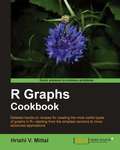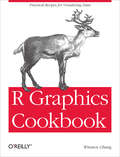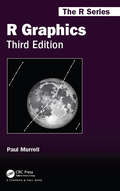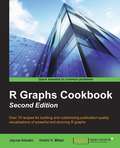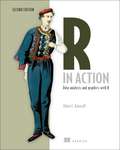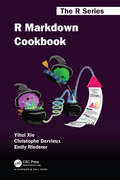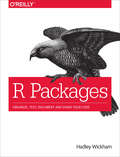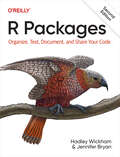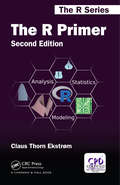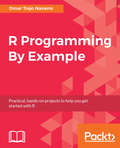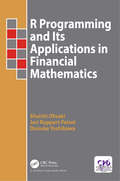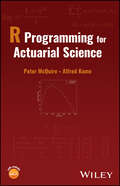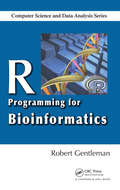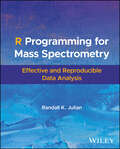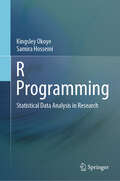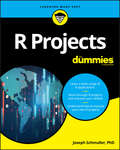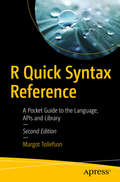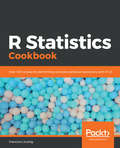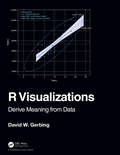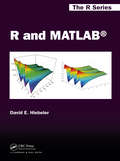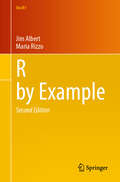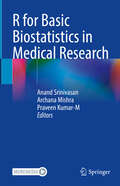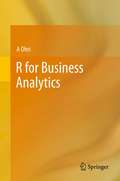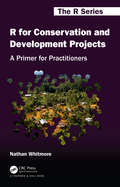- Table View
- List View
R Graph Cookbook
by Hrishi V. MittalThis hands-on guide cuts short the preamble and gets straight to the point - actually creating graphs, instead of just theoretical learning. Each recipe is specifically tailored to fulfill your appetite for visually representing you data in the best way possible. This book is for readers already familiar with the basics of R who want to learn the best techniques and code to create graphics in R in the best way possible. It will also serve as an invaluable reference book for expert R users.
R Graphics Cookbook: Practical Recipes for Visualizing Data
by Winston ChangThis practical guide provides more than 150 recipes to help you generate high-quality graphs quickly, without having to comb through all the details of R’s graphing systems. Each recipe tackles a specific problem with a solution you can apply to your own project, and includes a discussion of how and why the recipe works.Most of the recipes use the ggplot2 package, a powerful and flexible way to make graphs in R. If you have a basic understanding of the R language, you’re ready to get started.Use R’s default graphics for quick exploration of dataCreate a variety of bar graphs, line graphs, and scatter plotsSummarize data distributions with histograms, density curves, box plots, and other examplesProvide annotations to help viewers interpret dataControl the overall appearance of graphicsRender data groups alongside each other for easy comparisonUse colors in plotsCreate network graphs, heat maps, and 3D scatter plotsStructure data for graphing
R Graphics, Third Edition (Chapman & Hall/CRC The R Series)
by Paul MurrellThis third edition of Paul Murrell’s classic book on using R for graphics represents a major update, with a complete overhaul in focus and scope. It focuses primarily on the two core graphics packages in R - graphics and grid - and has a new section on integrating graphics. This section includes three new chapters: importing external images in to R; integrating the graphics and grid systems; and advanced SVG graphics.The emphasis in this third edition is on having the ability to produce detailed and customised graphics in a wide variety of formats, on being able to share and reuse those graphics, and on being able to integrate graphics from multiple systems.This book is aimed at all levels of R users. For people who are new to R, this book provides an overview of the graphics facilities, which is useful for understanding what to expect from R's graphics functions and how to modify or add to the output they produce. For intermediate-level R users, this book provides all of the information necessary to perform sophisticated customizations of plots produced in R. For advanced R users, this book contains vital information for producing coherent, reusable, and extensible graphics functions.
R Graphs Cookbook Second Edition
by Jaynal Abedin Hrishi V. MittalTargeted at those with an existing familiarity with R programming, this practical guide will appeal directly to programmers interested in learning effective data visualization techniques with R and a wide-range of its associated libraries.
R In Action: Data Analysis And Graphics With R
by Rob KabacoffR in Action, Second Edition presents both the R language and the examples that make it so useful for business developers. Focusing on practical solutions, the book offers a crash course in statistics and covers elegant methods for dealing with messy and incomplete data that are difficult to analyze using traditional methods. You'll also master R's extensive graphical capabilities for exploring and presenting data visually. And this expanded second edition includes new chapters on time series analysis, cluster analysis, and classification methodologies, including decision trees, random forests, and support vector machines.
R Markdown Cookbook (Chapman & Hall/CRC The R Series)
by Yihui Xie Christophe Dervieux Emily RiedererThis new book written by the developers of R Markdown is an essential reference that will help users learn and make full use of the software. Those new to R Markdown will appreciate the short, practical examples that address the most common issues users encounter. Frequent users will also benefit from the wide ranging tips and tricks that expose ‘hidden’ features, support customization and demonstrate the many new and varied applications of the software. After reading this book users will learn how to: Enhance your R Markdown content with diagrams, citations, and dynamically generated text Streamline your workflow with child documents, code chunk references, and caching Control the formatting and layout with Pandoc markdown syntax or by writing custom HTML and LaTeX templates Utilize chunk options and hooks to fine-tune how your code is processed Switch between different language engineers to seamlessly incorporate python, D3, and more into your analysis
R Markdown: The Definitive Guide (Chapman & Hall/CRC The R Series)
by Garrett Grolemund J. J. Allaire Yihui Xie<p>R Markdown: The Definitive Guide is the first official book authored by the core R Markdown developers that provides a comprehensive and accurate reference to the R Markdown ecosystem. With R Markdown, you can easily create reproducible data analysis reports, presentations, dashboards, interactive applications, books, dissertations, websites, and journal articles, while enjoying the simplicity of Markdown and the great power of R and other languages. <p>In this book, you will learn <p> <li>Basics: Syntax of Markdown and R code chunks, how to generate figures and tables, and how to use other computing languages <li>Built-in output formats of R Markdown: PDF/HTML/Word/RTF/Markdown documents and ioslides/Slidy/Beamer/PowerPoint presentations <li>Extensions and applications: Dashboards, Tufte handouts, xaringan/reveal.js presentations, websites, books, journal articles, and interactive tutorials <li>Advanced topics: Parameterized reports, HTML widgets, document templates, custom output formats, and Shiny documents. </p></li> <P><P><i>Advisory: This book offers only partial accessibility. We have kept it in the collection because it is useful for some of our members. Benetech is actively working on projects to improve accessibility issues such as these in the future.</i>
R Packages
by Hadley WickhamTurn your R code into packages that others can easily download and use. This practical book shows you how to bundle reusable R functions, sample data, and documentation together by applying author Hadley Wickham's package development philosophy. In the process, you'll work with devtools, roxygen, and testthat, a set of R packages that automate common development tasks. Devtools encapsulates best practices that Hadley has learned from years of working with this programming language.Ideal for developers, data scientists, and programmers with various backgrounds, this book starts you with the basics and shows you how to improve your package writing over time. You'll learn to focus on what you want your package to do, rather than think about package structure.Learn about the most useful components of an R package, including vignettes and unit testsAutomate anything you can, taking advantage of the years of development experience embodied in devtoolsGet tips on good style, such as organizing functions into filesStreamline your development process with devtoolsLearn the best way to submit your package to the Comprehensive R Archive Network (CRAN)Learn from a well-respected member of the R community who created 30 R packages, including ggplot2, dplyr, and tidyr
R Packages: Organize, Test, Document, and Share Your Code
by Jennifer Bryan Hadley WickhamTurn your R code into packages that others can easily install and use. With this fully updated edition, developers and data scientists will learn how to bundle reusable R functions, sample data, and documentation together by applying the package development philosophy used by the team that maintains the "tidyverse" suite of packages. In the process, you'll learn how to automate common development tasks using a set of R packages, including devtools, usethis, testthat, and roxygen2.Authors Hadley Wickham and Jennifer Bryan from Posit (formerly known as RStudio) help you create packages quickly, then teach you how to get better over time. You'll be able to focus on what you want your package to do as you progressively develop greater mastery of the structure of a package.With this book, you will:Learn the key components of an R package, including code, documentation, and testsStreamline your development process with devtools and the RStudio IDEGet tips on effective habits such as organizing functions into filesGet caught up on important new features in the devtools ecosystemLearn about the art and science of unit testing, using features in the third edition of testthatTurn your existing documentation into a beautiful and user friendly website with pkgdownGain an appreciation of the benefits of modern code hosting platforms, such as GitHub
R Primer (Chapman & Hall/CRC The R Series)
by Claus Thorn EkstromNewcomers to R are often intimidated by the command-line interface, the vast number of functions and packages, or the processes of importing data and performing a simple statistical analysis. The R Primer provides a collection of concise examples and solutions to R problems frequently encountered by new users of this statistical software. This new edition adds coverage of R Studio and reproducible research.
R Programming By Example: Practical, hands-on projects to help you get started with R
by Omar Trejo Peter C. FigliozziKey Features Get a firm hold on the fundamentals of R through practical hands-on examples Get started with good R programming fundamentals for data science Exploit the different libraries of R to build interesting applications in R Book Description R is a high-level statistical language and is widely used among statisticians and data miners to develop analytical applications. Often, data analysis people with great analytical skills lack solid programming knowledge and are unfamiliar with the correct ways to use R. Based on the version 3.4, this book will help you develop strong fundamentals when working with R by taking you through a series of full representative examples, giving you a holistic view of R. We begin with the basic installation and configuration of the R environment. As you progress through the exercises, you'll become thoroughly acquainted with R's features and its packages. With this book, you will learn about the basic concepts of R programming, work efficiently with graphs, create publication-ready and interactive 3D graphs, and gain a better understanding of the data at hand. The detailed step-by-step instructions will enable you to get a clean set of data, produce good visualizations, and create reports for the results. It also teaches you various methods to perform code profiling and performance enhancement with good programming practices, delegation, and parallelization. By the end of this book, you will know how to efficiently work with data, create quality visualizations and reports, and develop code that is modular, expressive, and maintainable. What you will learn Discover techniques to leverage R’s features, and work with packages Perform a descriptive analysis and work with statistical models using R Work efficiently with objects without using loops Create diverse visualizations to gain better understanding of the data Understand ways to produce good visualizations and create reports for the results Read and write data from relational databases and REST APIs, both packaged and unpackaged Improve performance by writing better code, delegating that code to a more efficient programming language, or making it parallel
R Programming and Its Applications in Financial Mathematics
by Shuichi Ohsaki Jori Ruppert-Felsot Daisuke YoshikawaThis book provides an introduction to R programming and a summary of financial mathematics. <P><P>It is not always easy for graduate students to grasp an overview of the theory of finance in an abstract form. For newcomers to the finance industry, it is not always obvious how to apply the abstract theory to the real financial data they encounter. Introducing finance theory alongside numerical applications makes it easier to grasp the subject. <P><P>Popular programming languages like C++, which are used in many financial applications are meant for general-purpose requirements. They are good for implementing large-scale distributed systems for simultaneously valuing many financial contracts, but they are not as suitable for small-scale ad-hoc analysis or exploration of financial data. The R programming language overcomes this problem. R can be used for numerical applications including statistical analysis, time series analysis, numerical methods for pricing financial contracts, etc. <P><P>This book provides an overview of financial mathematics with numerous examples numerically illustrated using the R programming language.
R Programming for Actuarial Science
by Peter McQuire Alfred KumeR Programming for Actuarial Science Professional resource providing an introduction to R coding for actuarial and financial mathematics applications, with real-life examples R Programming for Actuarial Science provides a grounding in R programming applied to the mathematical and statistical methods that are of relevance for actuarial work. In R Programming for Actuarial Science, readers will find: Basic theory for each chapter to complement other actuarial textbooks which provide foundational theory in depth. Topics covered include compound interest, statistical inference, asset-liability matching, time series, loss distributions, contingencies, mortality models, and option pricing plus many more typically covered in university courses. More than 400 coding examples and exercises, most with solutions, to enable students to gain a better understanding of underlying mathematical and statistical principles. An overall basic to intermediate level of coverage in respect of numerous actuarial applications, and real-life examples included with every topic. Providing a highly useful combination of practical discussion and basic theory, R Programming for Actuarial Science is an essential reference for BSc/MSc students in actuarial science, trainee actuaries studying privately, and qualified actuaries with little programming experience, along with undergraduate students studying finance, business, and economics.
R Programming for Bioinformatics (Chapman & Hall/CRC Computer Science & Data Analysis)
by Robert GentlemanDue to its data handling and modeling capabilities as well as its flexibility, R is becoming the most widely used software in bioinformatics. R Programming for Bioinformatics explores the programming skills needed to use this software tool for the solution of bioinformatics and computational biology problems.Drawing on the author's first-hand exper
R Programming for Mass Spectrometry: Effective and Reproducible Data Analysis
by Randall K. JulianA practical guide to reproducible and high impact mass spectrometry data analysis R Programming for Mass Spectrometry teaches a rigorous and detailed approach to analyzing mass spectrometry data using the R programming language. It emphasizes reproducible research practices and transparent data workflows and is designed for analytical chemists, biostatisticians, and data scientists working with mass spectrometry. Readers will find specific algorithms and reproducible examples that address common challenges in mass spectrometry alongside example code and outputs. Each chapter provides practical guidance on statistical summaries, spectral search, chromatographic data processing, and machine learning for mass spectrometry. Key topics include: Comprehensive data analysis using the Tidyverse in combination with Bioconductor, a widely used software project for the analysis of biological dataProcessing chromatographic peaks, peak detection, and quality control in mass spectrometry dataApplying machine learning techniques, using Tidymodels for supervised and unsupervised learning, as well as for feature engineering and selection, providing modern approaches to data-driven insightsMethods for producing reproducible, publication-ready reports and web pages using RMarkdown R Programming for Mass Spectrometry is an indispensable guide for researchers, instructors, and students. It provides modern tools and methodologies for comprehensive data analysis. With a companion website that includes code and example datasets, it serves as both a practical guide and a valuable resource for promoting reproducible research in mass spectrometry.
R Programming: Statistical Data Analysis in Research
by Samira Hosseini Kingsley OkoyeThis book is written for statisticians, data analysts, programmers, researchers, professionals, and general consumers on how to perform different types of statistical data analysis for research purposes using R object-oriented programming language and RStudio integrated development environment (IDE). R is an open-source software with a development environment (RStudio) for computing statistics and graphical displays through data manipulation, modeling, and calculation. R packages and supported libraries provide a wide range of functions for programming and analyzing of data. Unlike many of the existing statistical software, R has the added benefit of allowing the users to write more efficient codes by using command-line scripting and vectors. It has several built-in functions and libraries that are extensible and allows the users to define their own (customized) functions on how they expect the program to behave while handling the data, which can also be stored in the simple object system. Therefore, this book serves as both textbook and manual for R statistics particularly in academic research, data analytics, and computer programming targeted to help inform and guide the work of the users. It provides information about different types of statistical data analysis and methods, and the best scenarios for use of each case in R. It gives a hands-on step-by-step practical guide on how to identify and conduct the different parametric and nonparametric procedures. This includes a description of the different conditions or assumptions that are necessary for performing the various statistical methods or tests, and how to understand the results of the methods. The book also covers the different data formats and sources, and how to test for the reliability and validity of the available datasets. Different research experiments, case scenarios, and examples are explained in this book. The book provides a comprehensive description and step-by-step practical hands-on guide to carrying out the different types of statistical analysis in R particularly for research purposes with examples. Ranging from how to import and store datasets in R as objects, how to code and call the methods or functions for manipulating the datasets or objects, factorization, and vectorization, to better reasoning, interpretation, and storage of the results for future use, and graphical visualizations and representations thus congruence of Statistics and Computer programming in Research.
R Projects For Dummies
by Joseph SchmullerMake the most of R’s extensive toolset R Projects For Dummies offers a unique learn-by-doing approach. You will increase the depth and breadth of your R skillset by completing a wide variety of projects. By using R’s graphics, interactive, and machine learning tools, you’ll learn to apply R’s extensive capabilities in an array of scenarios. The depth of the project experience is unmatched by any other content online or in print. And you just might increase your statistics knowledge along the way, too! R is a free tool, and it’s the basis of a huge amount of work in data science. It's taking the place of costly statistical software that sometimes takes a long time to learn. One reason is that you can use just a few R commands to create sophisticated analyses. Another is that easy-to-learn R graphics enable you make the results of those analyses available to a wide audience. This book will help you sharpen your skills by applying them in the context of projects with R, including dashboards, image processing, data reduction, mapping, and more. Appropriate for R users at all levels Helps R programmers plan and complete their own projects Focuses on R functions and packages Shows how to carry out complex analyses by just entering a few commands If you’re brand new to R or just want to brush up on your skills, R Projects For Dummies will help you complete your projects with ease.
R Quick Syntax Reference: A Pocket Guide to the Language, APIs and Library
by Margot TollefsonThis handy reference book detailing the intricacies of R updates the popular first edition by adding R version 3.4 and 3.5 features. Starting with the basic structure of R, the book takes you on a journey through the terminology used in R and the syntax required to make R work. You will find looking up the correct form for an expression quick and easy. Some of the new material includes information on RStudio, S4 syntax, working with character strings, and an example using the Twitter API.With a copy of the R Quick Syntax Reference in hand, you will find that you are able to use the multitude of functions available in R and are even able to write your own functions to explore and analyze data.What You Will LearnDiscover the modes and classes of R objects and how to use themUse both packaged and user-created functions in R Import/export data and create new data objects in RCreate descriptive functions and manipulate objects in RTake advantage of flow control and conditional statementsWork with packages such as base, stats, and graphicsWho This Book Is ForThose with programming experience, either new to R, or those with at least some exposure to R but who are new to the latest version.
R Statistics Cookbook: Over 100 recipes for performing complex statistical operations with R 3.5
by Francisco JuretigSolve real-world statistical problems using the most popular R packages and techniques Key Features Learn how to apply statistical methods to your everyday research with handy recipes Foster your analytical skills and interpret research across industries and business verticals Perform t-tests, chi-squared tests, and regression analysis using modern statistical techniques Book Description R is a popular programming language for developing statistical software. This book will be a useful guide to solving common and not-so-common challenges in statistics. With this book, you'll be equipped to confidently perform essential statistical procedures across your organization with the help of cutting-edge statistical tools. You'll start by implementing data modeling, data analysis, and machine learning to solve real-world problems. You'll then understand how to work with nonparametric methods, mixed effects models, and hidden Markov models. This book contains recipes that will guide you in performing univariate and multivariate hypothesis tests, several regression techniques, and using robust techniques to minimize the impact of outliers in data.You'll also learn how to use the caret package for performing machine learning in R. Furthermore, this book will help you understand how to interpret charts and plots to get insights for better decision making. By the end of this book, you will be able to apply your skills to statistical computations using R 3.5. You will also become well-versed with a wide array of statistical techniques in R that are extensively used in the data science industry. What you will learn Become well versed with recipes that will help you interpret plots with R Formulate advanced statistical models in R to understand its concepts Perform Bayesian regression to predict models and input missing data Use time series analysis for modelling and forecasting temporal data Implement a range of regression techniques for efficient data modelling Get to grips with robust statistics and hidden Markov models Explore ANOVA (Analysis of Variance) and perform hypothesis testing Who this book is for If you are a quantitative researcher, statistician, data analyst, or data scientist looking to tackle various challenges in statistics, this book is what you need! Proficiency in R programming and basic knowledge of linear algebra is necessary to follow along the recipes covered in this book.
R Visualizations: Derive Meaning from Data
by David GerbingR Visualizations: Derive Meaning from Data focuses on one of the two major topics of data analytics: data visualization, a.k.a., computer graphics. In the book, major R systems for visualization are discussed, organized by topic and not by system. Anyone doing data analysis will be shown how to use R to generate any of the basic visualizations with the R visualization systems. Further, this book introduces the author’s lessR system, which always can accomplish a visualization with less coding than the use of other systems, sometimes dramatically so, and also provides accompanying statistical analyses. Key Features Presents thorough coverage of the leading R visualization system, ggplot2. Gives specific guidance on using base R graphics to attain visualizations of the same quality as those provided by ggplot2. Shows how to create a wide range of data visualizations: distributions of categorical and continuous variables, many types of scatterplots including with a third variable, time series, and maps. Inclusion of the various approaches to R graphics organized by topic instead of by system. Presents the recent work on interactive visualization in R. David W. Gerbing received his PhD from Michigan State University in 1979 in quantitative analysis, and currently is a professor of quantitative analysis in the School of Business at Portland State University. He has published extensively in the social and behavioral sciences with a focus on quantitative methods. His lessR package has been in development since 2009.
R and MATLAB (Chapman & Hall/CRC The R Series)
by David E. HiebelerThe First Book to Explain How a User of R or MATLAB Can Benefit from the Other In today’s increasingly interdisciplinary world, R and MATLAB® users from different backgrounds must often work together and share code. R and MATLAB® is designed for users who already know R or MATLAB and now need to learn the other platform. The book makes the transition from one platform to the other as quick and painless as possible. Enables R and MATLAB Users to Easily Collaborate and Share Code The author covers essential tasks, such as working with matrices and vectors, writing functions and other programming concepts, graphics, numerical computing, and file input/output. He highlights important differences between the two platforms and explores common mistakes that are easy to make when transitioning from one platform to the other.
R by Example (Use R!)
by Jim Albert Maria RizzoNow in its second edition, R by Example is an example-based introduction to the statistical computing environment that does not assume any previous familiarity with R or other software packages. R functions are presented in the context of interesting applications with real data. The purpose of this book is to illustrate a range of statistical and probability computations using R for people who are learning, teaching, or using statistics. Specifically, it is written for users who have covered at least the equivalent of (or are currently studying) undergraduate level calculus-based courses in statistics. These users are learning or applying exploratory and inferential methods for analyzing data, and this book is intended to be a useful resource for learning how to implement these procedures in R. The new edition includes expanded coverage of ggplot2 graphics, as well as new chapters on importing data and multivariate data methods.
R for Basic Biostatistics in Medical Research
by Anand Srinivasan Archana Mishra Praveen Kumar-MThe scientific community at the global level is fast becoming aware of the rising use of open-source tools such as R and Python for data analysis. Unfortunately, in spite of the awareness, the conversion of the intrigue to the practical knowledge in utilization of the open-source tools for routine day-to-day data analysis is seriously lacking both among physicians and medical scientists. This book enables physician-scientists to understand the complexity of explaining a programming/ data-analytic language to a healthcare professional and medical scientist. It simplifies and explains how R can be used in medical projects and routine office works. It also talks about the methodologies to convert the knowledge to practice. The book starts with the introduction to the structure of R programming language in the initial chapters, followed with explanations of utilizing R in the basics of data analysis like data importing and exporting, operations on a data frame, parametric and non-parametric tests, regression, sample size calculation, survival analysis, receiver operator characteristic analysis (ROC) and techniques of randomization. Each chapter provides a brief introduction to the involved statistics, for example, dataset, working codes, and a section explaining the codes. In addition to it, a chapter has been dedicated to describing the ways to generate plots using R. This book primarily targets health care professionals and medical/life-science researchers in general.
R for Business Analytics
by A OhriR for Business Analytics looks at some of the most common tasks performed by business analysts and helps the user navigate the wealth of information in R and its 4000 packages. With this information the reader can select the packages that can help process the analytical tasks with minimum effort and maximum usefulness. The use of Graphical User Interfaces (GUI) is emphasized in this book to further cut down and bend the famous learning curve in learning R. This book is aimed to help you kick-start with analytics including chapters on data visualization, code examples on web analytics and social media analytics, clustering, regression models, text mining, data mining models and forecasting. The book tries to expose the reader to a breadth of business analytics topics without burying the user in needless depth. The included references and links allow the reader to pursue business analytics topics. This book is aimed at business analysts with basic programming skills for using R for Business Analytics. Note the scope of the book is neither statistical theory nor graduate level research for statistics, but rather it is for business analytics practitioners. Business analytics (BA) refers to the field of exploration and investigation of data generated by businesses. Business Intelligence (BI) is the seamless dissemination of information through the organization, which primarily involves business metrics both past and current for the use of decision support in businesses. Data Mining (DM) is the process of discovering new patterns from large data using algorithms and statistical methods. To differentiate between the three, BI is mostly current reports, BA is models to predict and strategize and DM matches patterns in big data. The R statistical software is the fastest growing analytics platform in the world, and is established in both academia and corporations for robustness, reliability and accuracy. The book utilizes Albert Einstein's famous remarks on making things as simple as possible, but no simpler. This book will blow the last remaining doubts in your mind about using R in your business environment. Even non-technical users will enjoy the easy-to-use examples. The interviews with creators and corporate users of R make the book very readable. The author firmly believes Isaac Asimov was a better writer in spreading science than any textbook or journal author.
R for Conservation and Development Projects: A Primer for Practitioners (Chapman & Hall/CRC The R Series)
by Nathan WhitmoreThis book is aimed at conservation and development practitioners who need to learn and use R in a part-time professional context. It gives people with a non-technical background a set of skills to graph, map, and model in R. It also provides background on data integration in project management and covers fundamental statistical concepts. The book aims to demystify R and give practitioners the confidence to use it. Key Features:• Viewing data science as part of a greater knowledge and decision making system • Foundation sections on inference, evidence, and data integration • Plain English explanations of R functions • Relatable examples which are typical of activities undertaken by conservation and development organisations in the developing world • Worked examples showing how data analysis can be incorporated into project reports
